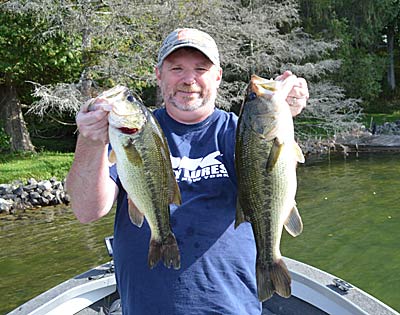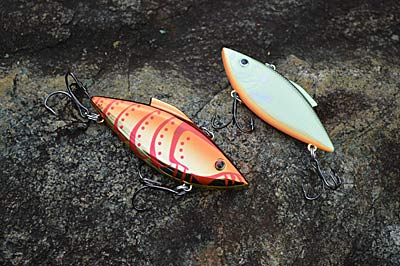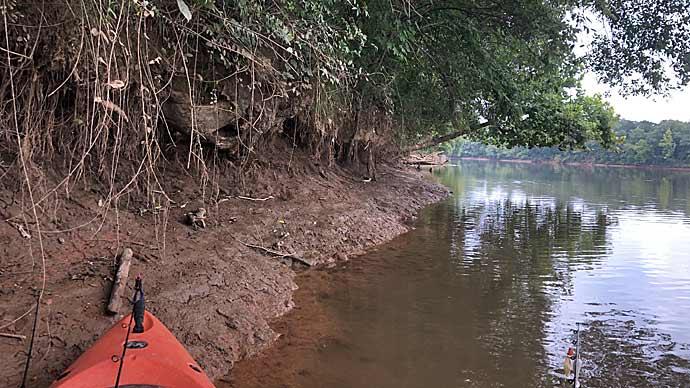
A bass angler’s best dreams feature these: Magical spots where one bite comes after another, and every fish is a chunk. The good news is that these aren't only figments of their imagination. They exist, including on the waters you regularly fish. The challenge is finding them.
There’s no getting around it. Discovering reliable and productive fishing spots takes work. Bass don’t swim everywhere in a lake, reservoir, or river. Every angler learns that lesson on their first day on the water. But finding them gets easier when you understand what makes a great fishing spot. That begins with identifying what bass want, including:
- Cover and structure: Bass use cover and structure for various reasons. Structure — changes in bottom contour — include points, creek channels, and humps. Bass use it to ambush prey and as a "road" between shallow and deep water. Cover — items that sit on the bottom — include aquatic vegetation, rock, and brush. Bass hide in it to shelter from environmental changes and ambush prey.
- Food: Bass have to eat, so they gravitate to spots with plenty of prey. You might see schools of baitfish on your electronics or moving under the surface. It could be bluegills milling around a row of boat docks in the summer. Crawfish, a bass favorite, are impossible to see, but a concentration of them will attract bass.
- Water quality: Bass may not be capable of understanding what they need, but they know it when they find it. That’s especially true with water conditions. Temperature and dissolved oxygen are two of the most important. But water color — clear, stained, or muddy — is essential, too. Bass seek out the best of each that’s available.
The particulars of these three points depend on where and when you’re fishing. So, don’t pigeonhole yourself into looking for aquatic vegetation or baitfish every time you hit the water. And none stand alone; instead, they all mesh in different combinations. You must look at the larger picture first, putting a sharper point on your approach as you learn more.
There’s a lot of water out there, so use these five steps to narrow it down to the best spots. And once you find that next hot spot, it’s up to you whether you tell your fishing buddies about it.
Understand How Bass React To Their Environment
Some spots are timeless, producing bass trip after trip and year after year. Those are the ones that are the basis of legends. But most have a time limit, only producing when conditions permit. So, it's essential to understand how bass react when conditions change.
Bass don’t process information like we do. There's no reasoning, logic, or consideration of choices. They react to their environment. For example, they slide into deeper water if the water level drops. Or if clouds blow in, they swim further from the cover where they were hiding when the sun was shining.
Seasonal changes are the overriding factor of bass location. Most bass swim toward shallow water in spring to spawn and in fall to chase baitfish. They move to deep water in summer and winter. Depth is relative. On a Western reservoir, where cover is sparse and water gin clear, shallow may be 20 feet. In an aquatic vegetation-choked natural lake in Florida, it may be less than 1 foot.
While seasons dictate overall movements and locations, condition changes dictate daily movements. Bass will move shallower and be more aggressive when the surface is ruffled by wind or water stained by recent rain-runoff. However, these minor adjustments are made about seasonal movements. Bass won't swim distances because the sun shines on a particular day. Weather changes will change a bass' mood, and the season changes location.
Studying how bass react to environmental changes is essential to bass fishing success. And being able to recall that information on the water is vital. But the only way to truly understand them is time on the water, where you can experience them in real-time. And the more experiences you have, the better angler you'll become because you can re-apply them when faced with similar situations in the future.
Study The Fishery
All hot spots aren't created equal, even though bass needs are the same wherever they swim. For example, what produces in a lake might not work in a river or reservoir. So, it's essential to study the features of where you are fishing. Online resources are an excellent place to start. But don't forget about classic paper maps. Poring over them can reveal things even the latest technology can't.
You're searching for something different, which acts like a bass magnet. A riprap bank, for example, may extend unwaveringly for a mile. And you may come across a bass here or there. But your odds of catching more go up significantly when you come across something different such as a point, adjacent bed of aquatic vegetation, or drainage culvert poking through. You can come across the same situation in a natural lake, where a hard spot rises in the middle of an aquatic vegetation-covered flat, or on a reservoir, where a creek channel makes a hard turn through a shallow flat.
Most state or provincial fisheries departments produce periodic fishing reports. While these spell out only the best-known — heavily fished — spots, they can provide vital information to direct you to where the bite is best. Add your detective work and understanding of bass and their needs, and you'll create a game plan for that body of water. You can also extrapolate it to similar waters nearby.
These reports come in a variety of forms. They may be a weekly or monthly update to a website. Sometimes, you need to subscribe to an email newsletter. Keep your eyes open for collections of angler diaries. These programs collect and present information voluntarily provided by local anglers. It allows you to go back in time and discover trends. You can use those to predict the future.
Talk To Locals
Image
A quick conversation with a local can help you find hot spots faster. An excellent place to start is at a tackle shop. If you’re headed to the Ohio River, Fisherman’s Headquarters in Dayton would be a good place to get some answers. Photo by Pete M. Anderson You should never be above asking for help when you need it, including when it comes to bass fishing. If you're headed to a body of water new to you, a few questions to the right person can get your trip headed in the right direction.
Tackle shops are a great place to start. The person behind the counter spends day in and out interacting with anglers who have recent firsthand knowledge of local fisheries. And if you’re throwing down a few bucks for a new lure or two, you can tap into it. Your questions don’t need to be pinpointed; it's difficult to reproduce a particular pattern. Instead, ask general questions: bite quality, depth, general locations, cover type, and water temperature. Use your knowledge of bass and favorite techniques to sew together that information.
Not all help is equal. Be cautious with information gleaned from social media posts. While there are some nuggets of truth to be found, you often must sift through information that's either regurgitated from a different source or untrue. The best tact is to use this information as a starting point and work to back it up with other sources.
And above all else, avoid following what’s commonly called “The Bent Rod Pattern.” Don’t encroach on other bass anglers having success. You can investigate after they leave to find out why that spot is so good so you can replicate it elsewhere. But it's poor sportsmanship to use that spot without getting their acknowledgment.
Study Past Tournament Results
Tournament anglers are a different breed. They feed off pressure, mostly self-applied, to produce bass, hopefully big enough to win within a set time. And when it all comes together, the feeling can be wonderful.
While the big bags steal most of the headlines, many tournaments are grinders, when competitors must push and work hard to assemble a limit. So, they always have a good idea of where and how to consistently catch bass. While top finishers won’t give away everything, they usually share enough to get you started. You also can learn a lot from the live coverage of top national circuits. It’s even better if you’re lucky enough for them to visit your home lake. Either way, you’ll get a good idea of where to look.
Get Out There
Image
Getting on the water is the final step in finding a hot spot. Your electronics will tell you if there are any bass home, but so will a couple of placed casts with a lure. Lipless crankbaits, for example, can be fished quickly at any depth and always seem to draw reaction strikes. Photo by Pete M. Anderson Nothing in bass fishing is more important than time on the water. Sure, the first four tips will get you close to your next hot spot, maybe right on top of it. But sealing the deal requires seeing if there are bass there. There's much good-looking water out there, but fishing is the only way to know if it's a hot spot.
Fishing electronics are excellent devices. Today's down scan and forward-facing sonar reveal details never seen before, from a bass chasing your lure in real time to the individual branches on the sunken brush. If you have access to this technology, and the depth and cover on the spots you're searching allow for its use, take full advantage of it. A few quick idling passes or scans will let you know if any bass exists.
While modern technology is fantastic and essential to finding a hot spot, you must eventually make a cast. While depth, current, cover, and structure will dictate the lure you use, some are better for searching. One of the best is a lipless crankbait. It can be fished at any depth and draws reaction strikes. A couple of quick casts, and you'll know what kind of cover is present and whether there's enough bass to consider it your newest hot spot.




